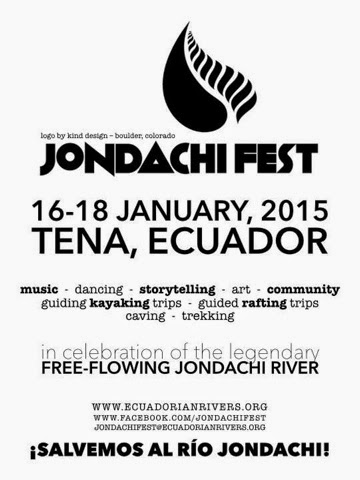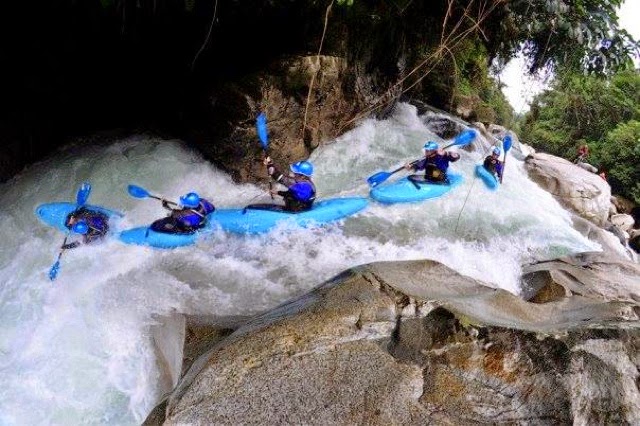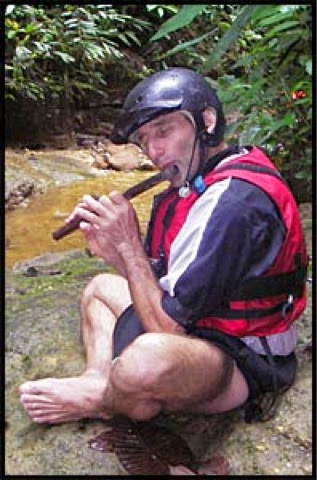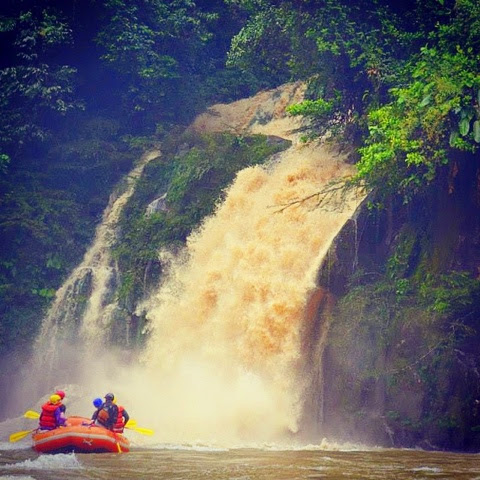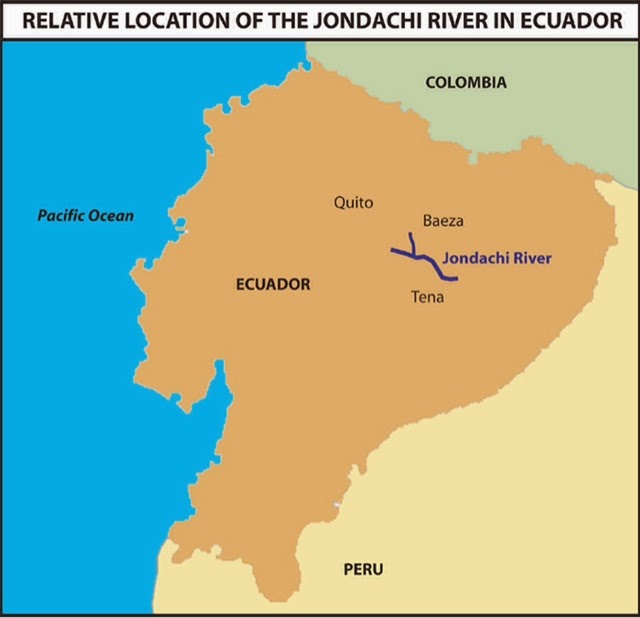This weekend Jondachi Fest is raging on and off the river in Tena, Ecuador, the whitewater capital of the country. The event, with races on the Class V Upper Jondachi and music and good times afterwards, was conceived and hosted by the Ecuadorian Rivers Institute. To quote the ERI website: “The world-renowned Jondachi River is threatened by a poorly-conceived hydroelectricity project. This river is part of one of the most pristine watersheds in Ecuador. Together, with Jondachi Fest as the catalyst for action, we will demonstrate and celebrate the Jondachi’s resource value as an integral piece of the proposed Jondachi-Hollín-Misahuallí-Napo Ecological Corridor. Preserving strategic free-flowing corridors which connect the Andes to the Amazon is essential to conserving biodiversity and aquatic ecosystems, as well as maintaining sustainable economic opportunities for this region. The Ecuadorian Rivers Institute is working to keep the Jondachi a free-flowing river and maintain its current condition. By participating in Jondachi Fest, you can help demonstrate to the Ecuadorian government that the Jondachi – as part of a FREE-FLOWING river corridor – is an intrinsically valuable resource.”
DBP MAGAZINE ONLINE contributing writer Daniel T Young is on hand running the river and reporting on the festival. He has interviewed a number of folks and we will be running his story and photos shortly. One must first focus on paddling and partying after all! He obtained permission for us to run this interview of ERI founder Matt Terry, which first ran on the Endless River Adventures website back in 2011, to set the table for his report and also tell the tale of how the Institute got it’s start and became the major player in the efforts to save the Rio Jondachi. The Festival is wrapping up today, and has been a great time and positive experience for all involved. Hopefully the ill-conceived project will be shelved and this dramatic watershed preserved for tomorrow. CHEERS & PURA VIDA to all participants!
If there was ever a person whose entire destiny became saving rivers, it might be Matt Terry. The founder of Ecuadorian Rivers Institute (ERI), Matt has dedicated the past 15 years to promoting environmental awareness in Ecuador—a country that struggles to balance the future with putting bread on the table today.
Matt Terry, where did your passion for whitewater/rivers come from?
“Paddling rivers everywhere! Every time I get out on the water I am reminded of why we need to protect these valuable resources.”
And then one day you decided to save the rivers of Ecuador….Why Ecuador? When?
“As a long-time member and supporter of American Whitewater, I have been actively involved in the river conservation movement for many years. AW is a constant source of inspiration and shows what is possible to achieve with experience, support, and dedication.”
“In the United States, we developed most of our rivers during the last century, and many conservation efforts have been directed towards restoring instream flows and mitigating the impacts caused by these dams and diversion structures, including removing them. Through that process, a growing social awareness developed that recognized the importance of preserving free-flowing river corridors and intact watersheds, along with the creation of specific laws and regulations that allowed for the designation of rivers with outstanding resource values for permanent protection and proper management, along with many other considerations that provide the impetus which help ensure adequate public participation and representation so that the best alternatives will be reached to face the growing demand for renewable energy and fresh water resources.”
“Around the world, we are losing incredible whitewater rivers at an unprecedented rate. In most of these cases, there are gross deficiencies, negligent abuses, and often a lack of legal structures which require government authorities, investors and developers to carry out legitimate processes of public participation, provide access to information, transparency in the decisions that are made, and the consideration of different user groups or opinions in the evaluation of alternatives during the development process. In these scenarios, development projects are often presented to meet nascent political agendas, the studies are later contracted to justify the proposed project, and sometimes other project alternatives are not even evaluated or discussed. Outside the United States, it becomes easier to appreciate the rights and processes that we have in our country to guarantee adequate land use planning, and to challenge inappropriate development, consider recreational use, preserve species and habitat, and protect areas with outstanding resource values.”
“While I was working in Chile in the mid-1990’s, I witnessed the loss of the Royal Flush Canyon on the Bio Bio River with the construction of the first stage of the Pangue hydroelectric complex. I was also at the Futaleufu River when Chris Spelius started his efforts to get the local community and the international paddling community involved to help save the most important sections of that river in Chile from being dammed. Both of those experiences left striking impressions upon me about the future of whitewater rivers throughout the world, as well as what we, as paddlers, need to do if we want to preserve some of these special places as paddling destinations. In the years that followed, I had the opportunity to live, work and travel on rivers in several countries in Central America and Southeast Asia, and gained a wider perspective on the current status and situations of the countries in these regions, as well as the pending plans for developing their water resources in the near future. Then I went to Ecuador.”
“Ecuador is a tropical whitewater paradise with year-round paddling on an endless variety of accessible rivers with amazing rapids and scenery. When I first arrived in Ecuador in 1997, the country was just starting to open up as an international paddling destination, and presented a refreshing outlook with great potential for the future. With the support of the Polartec Challenge and other industry sponsors, I organized a series of paddling expeditions to explore and document rivers all over the country. Through that effort, I came away with a clear perspective and overview of the current conditions and level of development in all of the main watersheds in the country, and knew which rivers and areas were important and worth saving. And in the process, I covered a lot of ground, paddled a lot of rivers, met a lot of people, and became known around the country.”
“What really impressed me was that Ecuador was at least 20 years behind the other countries in the region and the rest of the world in developing its water resources for hydroelectricity, and that Ecuador met about 50% of its electricity needs from just a handful of hydro projects that were located on rivers that were pretty much off the map for paddling interests. Another notable observation was the significant social and cultural ties that the local population had with the rivers for fishing, swimming, bathing, and floating. Also, at this point in time, the paddle sports industry began to reach a mainstream popularity that it had never seen before, and for the first time ever, represented strength in numbers and could manifest itself with real economic impact. Tourism is one of Ecuador’s most important sources of jobs and revenue, and river-based activities are a big part of what Ecuador has to offer. These factors presented very interesting opportunities to influence the development of water resources in Ecuador.”
“By the turn of the century, we were starting to see a lot of visible threats to the integrity of the rivers in Ecuador, and there was explicit interest to develop new hydro projects on a number of rivers that were important paddling destinations. Rafting and kayaking had successful inserted into the country’s tourism portfolio and became significant driving forces for several local economies, and it was apparent to me that there was still a chance to make a difference in Ecuador and something needed to be done. The idea occurred to organize a river festival and bring people together to raise awareness about the value of the rivers and the issues that we were concerned about. With an outpouring of help and interest, I organized the first Napo River Festival in 2001 to celebrate the importance of Ecuador’s last major free-flowing tributary of the Amazon that had protected headwaters. Based on the successful response from this event, and after evaluating a number of options and possibilities to reach our objectives, a group of people came together and formed the Ecuadorian Rivers Institute (ERI) as a non-profit river conservation organization in 2002. Since that time I have been committed to protecting unique watershed resources in Ecuador for the benefit of future generations. The ERI has a vested interest in river conservation, and is the only organization which works to protect the interests of recreational river users and specifically addresses watershed issues in Ecuador.”
You tackle about every environmental issue that impacts the rivers of the Oriente. Do you get a lot of support from the community? How about the government?
“The main reason why the ERI continues to work in Ecuador is from the positive feedback and support we have received from the local population. The ERI also benefits from a number of contacts and influences from people throughout the Ecuadorian government who recognize and support our efforts. Unfortunately, it is often difficult for many Ecuadorians to speak out and voice their concerns about issues without facing legal, political, or other repercussions, and developmental interests still dominate the decisions that are made regarding resource management and environmental considerations. It is this “pork barrel” development model, and the corruption that surrounds it, which remains to be the biggest obstacle to overcome. A large part of our efforts are directed towards trying to reach and educate these developers, the government, and the general public about the issues and show them a new vision of development that includes legitimate processes of environmental evaluation and public participation to ensure that projects are identified, selected and implemented in the best possible way, along with basic principles of environmental management which help create greater benefits for everyone involved while minimizing impacts. Chinese investment has made things considerably more difficult and challenging to work with, as projects are funded that normally would not move forward on their own merit or by traditional means.”
Do you see a light at the end of the tunnel in a country like Ecuador?
“It is a very long tunnel, but there must be an end. If not, since we are in Ecuador, the “tunnel” will surely collapse somewhere, and at some point, due to “inherent structural deficiencies”, and that will surely let some light in. We have enjoyed a number of successes, and continue to gain ground on a number of fronts. That is what keeps us going. However, we face some very complex issues, and our efforts remain as a steep uphill climb. We are convinced that by educating the key sectors to gain a proper understanding of the problems, we will be able to succeed in making a difference in the decisions that are made to resolve them.”
What is your biggest challenge for continuing the mission of ERI?
“The ERI is only limited by the capacity we have to work with. As a volunteer-based organization, everyone that is involved works in other jobs and capacities to make ends meet. This inherently limits our capacity and has created a rather vicious cycle of trying to keep up with all of the issues and projects we are involved with on a day-to-day basis, while keeping the organization alive, and attending to personal needs. Finding money and funding to sustain and grow the ERI as an organization is the biggest challenge, and the main limiting factor. Our funding comes predominately from the generous contributions of individual donors and small grants for specific project expenses. This valuable support helps to cover some basic expenses, but is not sufficient to support the organizational needs and operating expenses. Our attempts to apply for grants and funding from larger organizations and private foundations have not produced notable results, and we have found that it is a tough market to break into, and is a full-time effort. Meanwhile, the ERI has missed a number of opportunities to incorporate or maintain key staff, especially local Ecuadorians, by not being able to offer any paid compensation or benefits.”
Final Note from Juliet:
Like any struggling organization, one of ERI’s greatest challenges is just keeping ahead of the bills. They receive support from multiple sources—including the three top paddling companies in Ecuador: DeRiemner Adventures, Small World Adventures and Endless River Adventures. But there is never enough….if you have paddled in Ecuador or dream of doing so, supporting Ecuadorian Rivers Institute will help keep your dream alive.
PS from Matt: “On Wednesday, October 19, 2011, we suspended 4 illegal gravel mining operations on the Jatunyacu, Talag, and Hollin Rivers with the government authorities from Quito. Things are quite tense at the moment and I continue to receive personal threats regarding our legal actions against the gabion walls and the illegal instream gravel mining and gold mining here. At the same time, there is a growing support and awareness of these issues from the local population.”
Links:
ERI website with Jondachi Fest info: http://ecuadorianrivers.org/jondachi-fest/
ERI Facebook page :
Jondachi Fest Facebook page:
Endless River Adventures:
Boof Sessions video on Upper & Lower Jondachi:

